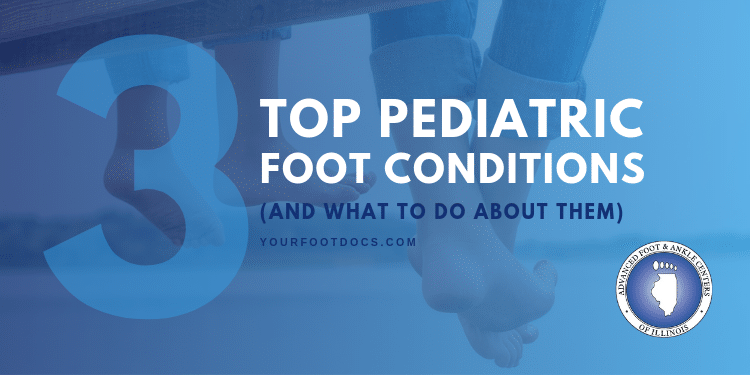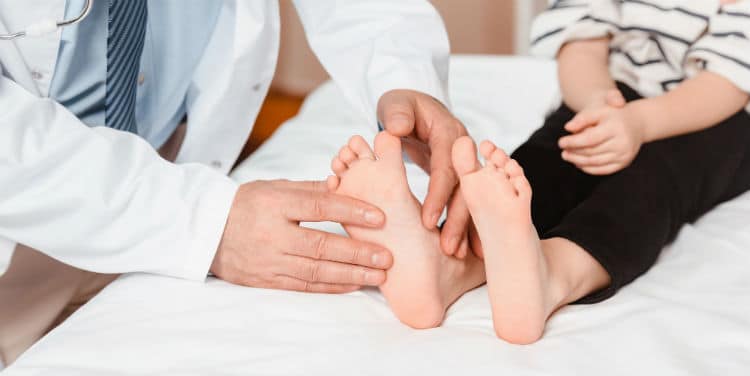Top 3 Pediatric Foot Conditions (And What to Do About Them)
If you are parent, then you already know the routine – we tell our kids to brush their teeth before bed, to eat their vegetables before leaving the dinner table, and to wash behind their ears in the shower. But in the midst of this struggle, we often forget about their feet.
However, this should be far from the case – during their childhood, our children’s feet grow at a fast rate and sometimes they can suffer from foot pain and discomfort. In fact, children are affected by many of the same foot problems as us parents from flat feet and heel pain to ingrown toenails and plantar warts.
This is attributed to their still developing bodies and active lifestyle – some injuries may result from playing sports while others can be due to their genetics. And, though most of these conditions are fairly common amongst our little ones, some can be serious and should be immediately addressed by a podiatrist.
It is also worth mentioning that children often can’t recognize when there is actually something wrong. A painful heel or ingrown toenail can go unnoticed merely because our children don’t quite know how to communicate their symptoms. So, as parents, we should pay close attention to things like their walking gait and the shape of their feet.
The bottom line is that you should never dismiss pains as normal or “not a big deal” – if your child is complaining of pain in their foot or ankle, then it is definitely time to see a podiatrist.
The good news is that at Advanced Foot & Ankle Center of Illinois offices, we provide expert pediatric care for your child’s foot and ankle conditions. So, keep reading our blog to find out what common symptoms and conditions you should be in the lookout for and how we can help!
Top 3 Pediatric Foot Conditions
Now, as much as we want to, we can’t just keep our children in a bubble until they are done growing – getting them outside is healthy and keeps them active. However, there are a few conditions and injuries you can at least be aware of in order to ensure the health and safety of your child’s feet and ankles.
By better understanding what conditions are most common in children and the non-verbal cues associated with them, it can be easier to recognize when your child needs to be evaluated by a podiatrist.
Below are the top 3 conditions and injuries that are commonly experienced by children:
- Flat Feet
It is actually normal in infants and young children to have flat feet as the muscles and tissues in those parts of their bodies haven’t completely formed yet. So if your child has flat feet, there is no need for treatment unless, of course, this condition is causing your child pain and affecting their daily activities.
However, children should outgrow their flatfeet by the age of six – though, approximately 20 percent of children don’t. Whenever that is the case, it is likely that the condition is hereditary, and you should visit our office for a thorough examination and to determine what type of treatment is best for your child.
- Developmental conditions.
Some of the most common types of developmental conditions are in-toeing – when the feet point inward while walking, out-toeing – when the feet point outward while walking, and toe walking – when the child walks on their toes or balls of their feet (this is something which is often seen in children as they are learning to walk).
If your child does not grow out of these conditions by early childhood, they can become a problem as they enter adolescence and adulthood. In most cases, these conditions can be managed with orthotics for children, which can be prefab or custom-made. Our podiatrists will help you determine which would be the best option for your child.
- Sports injuries.
Ankle or foot sprains are especially common amongst our highly active children who play sports like soccer or football. These sprains occur when the ligaments connected to the bones are stretched farther than they are meant to be.
Ankle sprains are particularly dangerous when they affect your child’s developing bones and cartilage as this can result in growth plate fractures. Though, these oftentimes heal without too much of a problem, it is vital to see a podiatrist whenever an injury does takes place – once we evaluate the condition we can determine if your child’s foot needs to be immobilized or if monitoring and icing the injury is enough to avoid any future complications.
The common factor here is: always seek the advice of a podiatrist when your child is experiencing any type of foot pain or condition. As they are still developing, all foot and ankle problems need to be addressed immediately in order to prevent any detrimental, long-lasting problems throughout their adulthood. Often orthotics will be prescribed.
Symptoms Parents Should Look For
As we already have mentioned, children with foot problems not always know how to communicate what they are feeling. Though, there are several non-verbal cues which may clearly indicate that something is wrong.
Some of these non-verbal cues include:
- You child doesn’t want to participate in activities they usually enjoy. In this case, foot or heel pain may be reason.
- Your child cannot keep up with their peers, particularly when running.One reason for this could be flat feet, which can also be helped through the use of orthotics.
- Your child trips or falls often, especially when running. This can be an indicator of foot imbalance, or developmental or structural issues, which can often be managed through the use of orthotics.
- Your child avoids showing you their feet.Your child may be trying to conceal a visible foot condition, such as fungal toenails or athlete’s foot.
- Your child complains of pain in their lower extremities. It is never normal for a child to have foot pain. If your child complains of any type of foot and ankle, then be sure to schedule an evaluation with one of our podiatrists.
- Your child is presenting unusual gait patterns. Watch for your child’s feet pointing inward or pointing outward when walking. Also watch to see if they continue to walk on their toes after the first 2-3 months of walking.
If you have noticed one or more these signs in your child’s behavior, there is no need to panic!
We Can Help You and Your Child!
Here at Advanced Foot & Ankle Centers of Illinois, your child will receive excellent care. We will work closely with you and your child to determine the correct diagnosis and customize a treatment plan aimed to eradicate whatever condition we may diagnose.
All you have to do is schedule an appointment with us! Simply call the office most convenient to your location or fill out our handy request form online. We have offices located in Joliet, Kenosha, Orland Park, Palatine, and Schaumburg, as well as two locations in Chicago.


